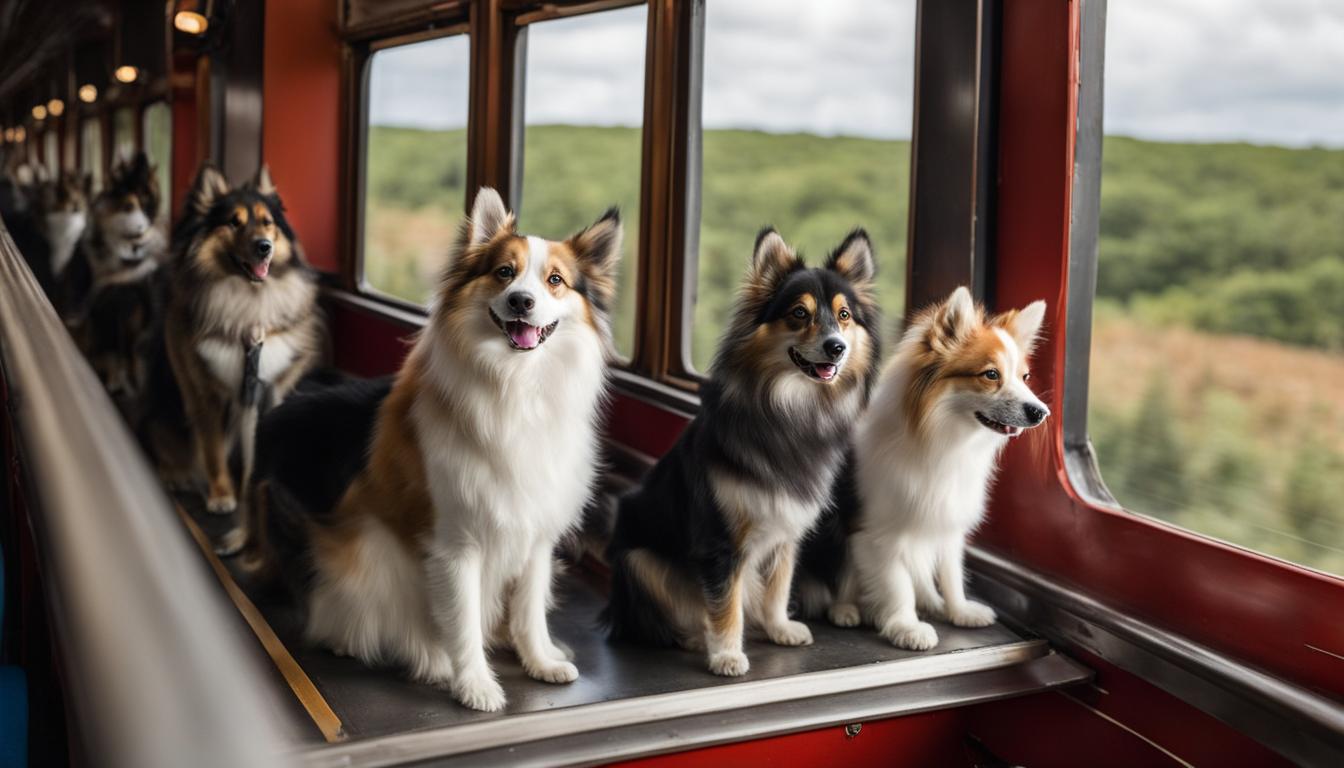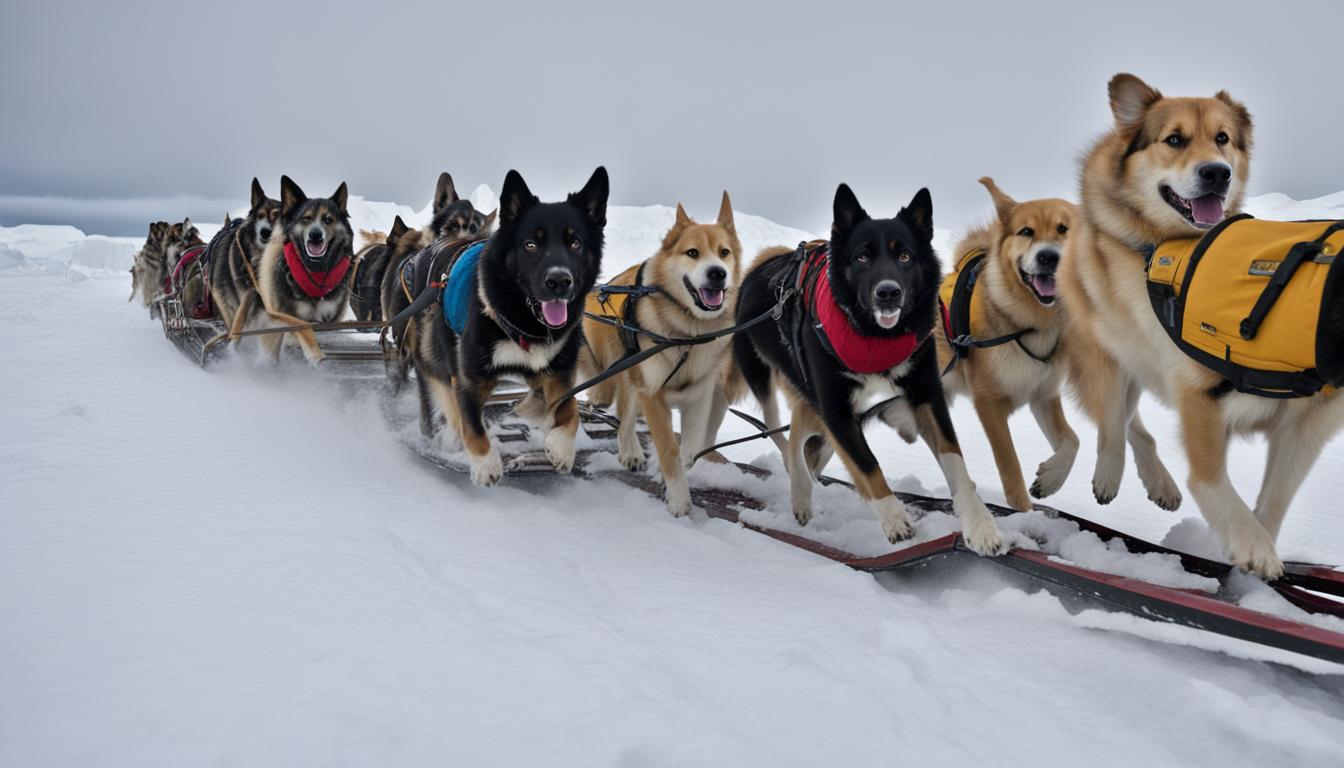Historic Trade Route Dogs have played a significant role in shaping America’s trade history. These dogs, which belonged to explorers, traders, and travelers, were loyal companions and invaluable helpers along the historic trade routes that crisscrossed the continent. From the famous Newfoundland waterdog Seaman, who accompanied Captain Meriwether Lewis on the Lewis and Clark Expedition, to the dogs used in dog sledding on the Klondike Gold Rush trails, these historic trade route dogs were an integral part of American history. They provided protection, assistance in hunting, transportation, and companionship, enabling humans to navigate vast distances and harsh environments. Let’s take a closer look at some of these remarkable dog breeds and their contributions to American trade history.
Key Takeaways:
- Historic Trade Route Dogs played a vital role in America’s trade history.
- These dogs were companions and helpers for explorers and traders.
- They provided protection, assistance, and companionship along trade routes.
- Notable examples include Seaman from the Lewis and Clark Expedition and sled dogs on the Klondike Gold Rush trails.
- These dogs were essential for navigating vast distances and harsh environments.
The Role of Dogs in the Lewis and Clark Expedition
One of the most famous examples of a historic trade route dog is Seaman, the Newfoundland waterdog that accompanied Captain Meriwether Lewis on the Lewis and Clark Expedition. Seaman played a vital role in the expedition, serving as a powerful hunter, vigilant watchdog, and devoted companion. Although his presence was initially left out of the published accounts, the complete journals of the expedition revealed Seaman’s significant contributions to the success of the journey.
Lewis mentioned Seaman’s hunting skills, ability to swim and retrieve squirrels, and his overall strength and docility. The dog’s name has been the subject of debate, but Seaman is the widely accepted name. Seaman’s story exemplifies the important role that historic trade route dogs played in supporting explorers and traders during their arduous journeys.
“[Seaman] is the best dog I ever saw. He understands perfectly every word that is said to him; he is more civilized than any other dog. Surely, if a dog has a soul, this dog is immortal.” – Meriwether Lewis.
Seaman’s remarkable hunting prowess and unwavering loyalty made him an invaluable asset to the Corps of Discovery. He provided the expedition with fresh game, alerted them to potential dangers, and provided emotional support during the challenging and uncertain times they faced. The Lewis and Clark Expedition’s success was undoubtedly enhanced by the presence of Seaman, a historic trade route dog who became a cherished member of the Corps.
The Significance of Seaman’s Contribution
Seaman’s inclusion in the Lewis and Clark Expedition played a crucial role in shaping American history. His skills as a hunter ensured that the expedition had a steady supply of fresh food, reducing their reliance on preserved rations. Additionally, Seaman’s presence provided emotional support and companionship to the members of the Corps, boosting morale during the long and arduous journey.
The Newfoundland waterdog breed, known for their strength, swimming abilities, and intelligence, was an ideal choice for the expedition. Seaman’s adaptability to various terrains, ranging from dense forests to treacherous rivers, made him an invaluable asset in navigating the uncharted territories of the American West.
Table: Seaman’s Contributions to the Lewis and Clark Expedition
| Contributions | Description |
|---|---|
| Hunting | Seaman’s hunting skills provided the expedition with fresh game, reducing their reliance on preserved rations. |
| Alertness | Seaman alerted the Corps of Discovery to potential dangers, acting as a vigilant watchdog throughout the journey. |
| Companionship | Seaman’s presence provided emotional support and companionship to the members of the Corps, boosting morale during challenging times. |
| Adaptability | Seaman’s ability to swim and traverse various terrains made him an invaluable asset in navigating the uncharted territories of the American West. |
Discovering Seaman’s Legacy
Seaman’s story has captured the imagination of many, shedding light on the incredible bond between humans and dogs throughout history. Today, Seaman’s legacy serves as a reminder of the important role that dogs played in supporting explorers and traders along historic trade routes. His contributions to the Lewis and Clark Expedition highlight the unwavering loyalty, intelligence, and adaptability that characterize historic trade route dogs.
As we delve deeper into the history of trade routes and the integral role of dogs, it becomes evident that these remarkable animals were not just companions but indispensable partners in shaping America’s trade history.

In conclusion, dog sledding played a vital role in the ancient trade routes of Siberia and beyond. The discovery of Zhokhov’s remains and the presence of dog sledding equipment provide evidence of the long-standing tradition of harnessing dogs for transportation. This practice enabled explorers and traders to overcome challenging terrains and establish trade networks, contributing to the growth of economies and the exchange of cultures. Dog sledding is a testament to the exceptional teamwork between humans and animals and remains an integral part of our history and heritage.
Conclusion
Historic Trade Route Dogs have left a lasting imprint on American trade history. These remarkable dogs were more than just companions; they were essential partners in the success of trade expeditions and exploration. From the famous Newfoundland waterdog Seaman, who accompanied Captain Meriwether Lewis on the Lewis and Clark Expedition, to the sled dogs that braved frozen landscapes along ancient trade routes, these dogs played a vital role in shaping America’s trade history.
The Lewis and Clark Expedition serves as a prime example of the significant contributions of historic trade route dogs. Seaman, the loyal Newfoundland waterdog, proved his worth as a powerful hunter, watchful guardian, and steadfast companion. His hunting prowess and unwavering loyalty aided the Corps of Discovery in their journey across the continent, even though his role was initially overlooked in published accounts. Seaman’s story highlights the important bond between humans and dogs in the face of challenging expeditions.
Another fascinating aspect of historic trade route dogs is their role in dog sledding. This ancient practice, dating back thousands of years, allowed explorers and traders to conquer frozen landscapes and establish trade networks. The discovery of Zhokhov, the oldest domesticated dog on Zhokhov Island, along with evidence of dog sledding equipment, solidifies the long history of this remarkable companionship. Dog sledding became an essential mode of transportation in the polar north, enabling traders to navigate vast icy terrains.
Today, as we delve into the stories of these historic trade route dogs, we continue to appreciate their legacy and the impact they had on American trade history. Their strength, loyalty, and adaptability made them indispensable allies in traversing long distances, providing food, and offering companionship during arduous journeys. These dogs symbolize the incredible bond between humans and animals and serve as a testament to the resilience and resourcefulness of both. Explore their fascinating stories to uncover the rich history they helped shape in American trade.
FAQ
What role did dogs play in American trade history?
Dogs played a significant role in shaping America’s trade history. They were loyal companions and invaluable helpers along historic trade routes, providing protection, assistance in hunting, transportation, and companionship to explorers, traders, and travelers.
Can you give an example of a famous historic trade route dog?
One of the most famous examples is Seaman, the Newfoundland waterdog that accompanied Captain Meriwether Lewis on the Lewis and Clark Expedition. Seaman served as a powerful hunter, vigilant watchdog, and devoted companion throughout the journey.
How did dog sledding contribute to trade routes?
Dog sledding was an essential mode of transportation for explorers and traders, enabling them to traverse vast frozen landscapes and establish trade networks. It originated from the indigenous peoples of Siberia and spread across polar regions, including modern-day Russia, Alaska, Canada, Greenland, and Scandinavia.
What is the significance of Zhokhov in dog sledding history?
Zhokhov is the oldest known domesticated dog and was found on Zhokhov Island in the Eastern Siberian Sea along with traces of dog sledding equipment. DNA analysis confirmed the shared genetic origin between modern sled dogs and Zhokhov, providing insights into the long history of dog sledding.
How did historic trade route dogs impact American trade history?
Historic trade route dogs were integral to the success of trade expeditions and exploration. Their strength, loyalty, and adaptability made them indispensable for traversing long distances, hunting for food, and providing companionship. They symbolize the bond between humans and animals and the vital role that dogs played in shaping America’s trade history.





